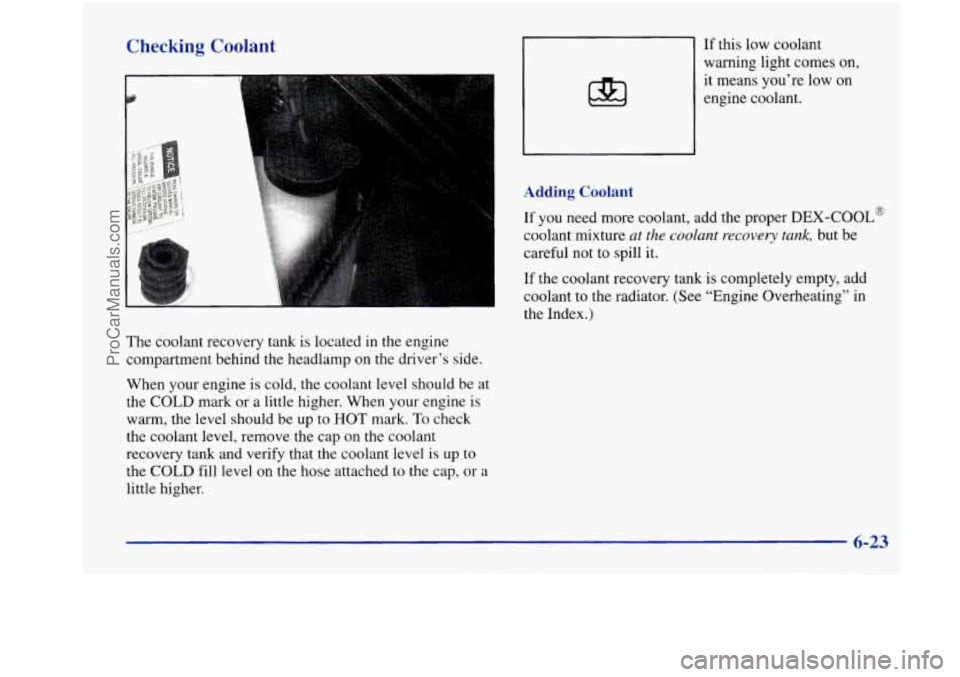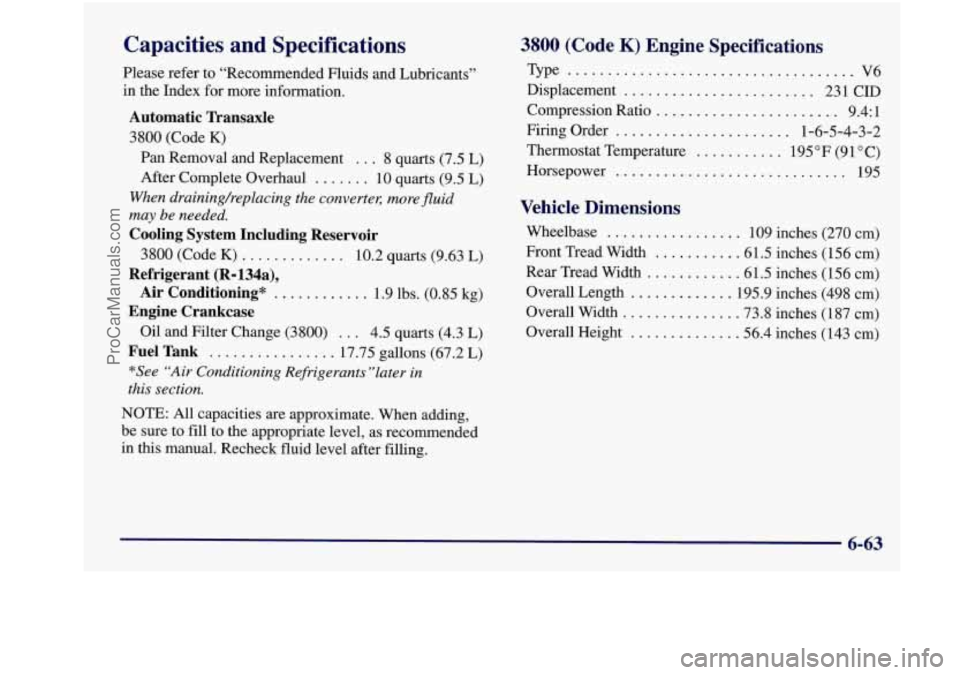engine OLDSMOBILE INTRIGUE 1998 Manual Online
[x] Cancel search | Manufacturer: OLDSMOBILE, Model Year: 1998, Model line: INTRIGUE, Model: OLDSMOBILE INTRIGUE 1998Pages: 340, PDF Size: 17.93 MB
Page 251 of 340

Checking Coolant
The coolant recovery tank is located in the engine
compartment behind the headlamp on
the driver’s side.
When your engine is cold, the coolant level should be at
the COLD mark or a little higher. When your engine is
warm, the level should be up to
HOT mark. To check
the coolant level, remove the cap on the coolant
recovery tank and verify that the coolant level is up to
the COLD fill level on the hose attached to
the cap, or a
little higher.
&I If this low coolant
warning light comes on,
it means you’re low on
engine coolant.
Adding Coolant
If you need more coolant, add the proper DEX-COOL@
coolant mixture
at the coolant recovery tank, but be
careful not to spill it.
If the coolant recovery tank is completely empty, add
coolant to
the radiator. (See “Engine Overheating” in
the Index.)
6-23
ProCarManuals.com
Page 252 of 340

'
A CAUTION: I
'hrning the radiator pressure cap when the
engine and radiator are hot can allow steam and
scalding liquids to blow out and burn you badly.
With the coolant recovery tank, you will almost
never have to add coolant at the radiator.
Never turn the radiator pressure cap
-- even a
little -- when the engine and radiator are hot.
You can be burned if
you spill coolant on hot
engine parts. Coolant contains ethylene glycol,
and it will burn if the engine parts are hot
enough. Don't spill coolant on
a hot engine.
Radiator Pressure Cap
NOTICE:
Your radiator cap is a 15 psi (105 kPa)
pressure-type cap and must be tightly installed
to
prevent coolant loss and possible engine damage
from overheating. Be sure the arrows
on the cap
line up with the overflow tube
on the radiator
filler neck.
When you replace your radiator pressure cap, an
AC@
cap is recommended.
Thermostat
Engine coolant temperature is controlled by a thermostat
in the engine coolant system.
The thermostat stops the
flow of coolant through the radiator until the coolant
reaches a preset temperature.
When you replace your thermostat, an
AC@ thermostat
is recommended.
6-24
ProCarManuals.com
Page 253 of 340

Power Steering Fluid
When to Check Power Steering Fluid
It is not necessary to regularly check power steering
fluid unless you suspect there is a leak in the system or
you hear an unusual noise. A fluid loss
in this system
could indicate
a problem. Have the system inspected
and repaired.
How To Check Power Steering Fluid
When the engine compartment is cool, wipe the cap and
the top
of the reservoir clean, then unscrew the cap and wipe the
dipstick with a clean rag. Replace the cap and
completely tighten it. Then remove the cap again and
look at the fluid level on the dipstick.
The level should be at the
FULL COLD mark. If
necessary, add only enough fluid to bring the level up
to the mark.
What to Use
To determine what kind of fluid to use, see
“Recommended Fluids and Lubricants” in
the Index.
Always use the proper fluid. Failure to use the proper
fluid can cause leaks and damage hoses and seals.
ProCarManuals.com
Page 254 of 340

Windshield Washer Fluid
What to Use
When you need windshield washer fluid, be sure to read
the manufacturer’s instructions before use. If you will be
operating your vehicle in an area where the temperature
may fall below freezing, use a fluid that has sufficient
protection against freezing.
Adding Washer Fluid
0
0
0
0
Open the cap labeled WASHER FLUID ONLY. Add
washer fluid until the tank is full.
NOTICE:
When using concentrated washer fluid,
follow the manufacturer’s instructions for
adding water.
Don’t mix water with ready-to-use washer
fluid. Water can cause the solution to freeze
and damage your washer fluid tank and
other parts
of the washer system. Also,
water doesn’t clean as well as washer fluid.
Fill your washer fluid tank only
three-quarters full when it’s very cold. This
allows for expansion if freezing occurs,
which could damage the tank
if it is
completely full.
Don’t use engine coolant (antifreeze) in
your windshield washer. It can damage
your washer system and paint.
6-26
ProCarManuals.com
Page 255 of 340

Brakes
Brake Fluid
goes back up. The other reason is that fluid is leaking out
of the brake system. If it is, you should have your brake
system fixed, since a leak means that sooner or later your
brakes won’t work
well, or won’t work at all.
So, it isn’t a good idea to “top off’ your brake fluid.
Adding brake fluid won’t correct
a leak. If you add fluid
when your linings are worn, then you’ll have too much
fluid when you get new brake linings. You should add
(or remove) brake fluid,
as necessary, only when work is
done on the brake hydraulic system.
Your brake master cylinder reservoir
is here. It is filled
with
DOT-3 brake fluid.
There are only two reasons why the brake fluid level
in the
reservoir might go down. The first is that the brake fluid
goes down to
an acceptable level during normal brake
lining wear.
When new linings are put in, the fluid level
If’ you have too much brake fluid, it can spa on the
engine. The fluid
will burn if‘ the engine is hot
enough. You or others could be burned, and
your
vehicle could be damaged. Add brake fluid only
when work
is done on the brake hydraulic system.
When your brake fluid falls to a low level, your brake
warning light will come on. See “Brake System Warning
Light”
in the Index.
6-27
ProCarManuals.com
Page 256 of 340

What to Add
When you do need brake fluid, use
only DOT-3 brake
fluid -- such as Delco Supreme ll@ (GM Part
No. 12377967). Use new brake fluid from a sealed
container only.
Always clean the brake fluid reservoir cap and
the area
around the cap before removing it. This
will help keep
dirt from entering the reservoir.
With the wrong kind
of fluid in your brake
system, your brakes may
not work well, or they
may not even work at all. This could cause
a
crash. Always use the proper brake fluid.
-- 1
NOTICE:
Using the wrong fluid can badly damage
brake system parts. For example, just
a few
drops of mineral-based oil, such as engine
oil, in your brake system can damage brake
system parts
so badly that they’ll have to be
replaced. Don’t let someone put in the
wrong kind of fluid.
0 If you spill brake fluid on your vehicle’s
painted surfaces, the paint finish can be
damaged. Be careful not
to spill brake fluid
on your vehicle. If you do, wash it off
immediately. See “Appearance Care” in
the Index.
6-28
ProCarManuals.com
Page 283 of 340

Vehicle Identification Number (VIN)
SAMPLE4UXWM072675 (GMI
ENGINEA98 f ASSEMBLY
CODE MODEL YEAR PLANT
Engine Identification
The 8th character in your VIN is the engine code. This
code will help you identify your engine, specifications
and replacement
parts.
Service Parts Identification Label
You’ll find this label on your spare tire cover. It’s very
helpful if you ever need
to order parts. On this label is:
your VIN,
the model designation,
This is the legal identifier for
your vehicle. It appears on
a plate in the front corner of the instrument panel,
on the
driver’s side. You can see it if you look through the
paint information and
windshield from outside your vehicle. The VIN also
appears
on the Vehicle Certification and Service Parts
labels and the certificates of title and registration. a list of all production options and
special equipment.
Be sure that this label is not removed from the vehicle.
6-55
ProCarManuals.com
Page 288 of 340

Underhood Electrical Center -- Passenger’s Side
Some fuses are in the underhood electrical centers on
the passenger’s side of the engine compartment.
12)
13)
14)
I5 1
(71
Fuse
1
2
3
4
5
6
U
Description
Cooling Fan
Starter Solenoid
Power Seats, Rear Defog, Heated Seats
High Blower, Hazard Flasher, Stoplamps,
Power Mirror, Door Locks
Ignition Switch, BTSI, Stoplamps,
ABS,
Turn Signals, Cluster, Air Bag, DRL Module
Cooling Fan
6-60
ProCarManuals.com
Page 290 of 340

Fuse
30 31
32
33
34
35
36
37
38 39
40
41
42
43
Description
Engine Emissions
Not Used
Headlamp (Right)
Rear Compartment Release
Parking Lamp
Fuel Pump
Headlamp (Left) Spare
Spare
Spare
Spare
Spare Spare
Fuse Puller
Replacement Bulb Numbers
Exterior Lamps Number
Back-up ............................... 3057
Center High-Mounted Stop
In Spoiler ............................. 891
OnShelf
............................. 1141
Fog
.................................... 893
Front Parking/Turn Signal
............. 4 157NAK
Headlamp. High Beam
.................... 9005
Headlamp.
Low Beam .................... 9006
License Plate
............................ 194
Sidemarker. Front
......................... 194
Sidemarker. Rear
......................... 194
Stopmail
............................... 3057
Turn Signal (Rear)
....................... 3057
Cornering
.............................. 3156
6-62
ProCarManuals.com
Page 291 of 340

Capacities and Specifications
Please refer to “Recommended Fluids and Lubricants”
in the Index for more information.
Automatic Transaxle
3800 (Code K)
Pan Removal and Replacement ... 8 quarts (7.5 L)
After Complete Overhaul ....... 10 quarts (9.5 L)
When drainingheplacing the converter; more fluid
may be needed.
Cooling System Including Reservoir
3800 (Code K) ............. 10.2 quarts (9.63 L)
Refrigerant (R-l34a),
Air Conditioning*
............ 1.9 lbs. (0.85 kg)
Engine Crankcase
Oil and Filter Change (3800) ... 4.5 quarts (4.3 L)
Fuel Tank ................ 17.75 gallons (67.2 L)
*See “Air Conditioning Refrigerants ”later in
this section.
NOTE: All capacities are approximate. When adding,
be sure to fill to the appropriate level, as recommended
in
this manual. Recheck fluid level after filling.
3800 (Code K) Engine Specifications
Type .................................... V6
Displacement
........................ 231 CID
Compression Ratio
....................... 9.4: 1
Firing Order ...................... 1-6-5-4-3-2
Thermostat Temperature
........... 195°F (91°C)
Horsepower
............................. 195
Vehicle Dimensions
Wheelbase ................. 109 inches (270 cm)
Front Tread Width
.......... .6 1.5 inches (1 56 cm)
Rear Tread Width
........... .6 1.5 inches (156 cm)
Overall Length
............. 195.9 inches (498 cm)
Overall Width
.............. .73.8 inches (1 87 cm)
Overall Height
.............. 56.4 inches (143 cm)
6-63
ProCarManuals.com